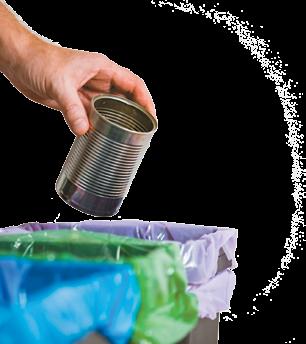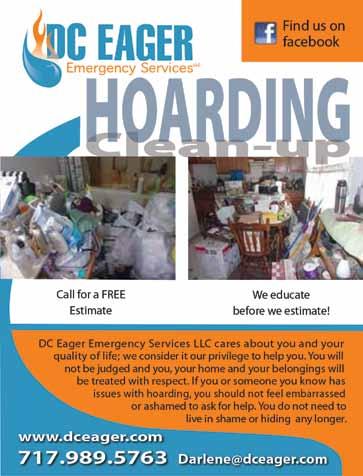
4 minute read
green living
Wishful Recycling What Not to Put in the Bin
by Yvette C. Hammett
Advertisement
For those that have been putting recyclables in a plastic bag and placing it in a curbside bin, it’s likely going straight into a landfill. That bowling ball, those yard clippings and dirty pizza boxes are contaminating the recycling stream and increasing the cost of recycling programs nationwide at a particularly challenging time amidst the COVI D-19 pandemic. The continuing rise in contaminated items is known in the biz as “wishful recycling”. The current crisis is only making it worse. In some places, recycling itself is becoming wishful.
As stores and restaurants struggle to survive, local tax revenues have dropped sharply, forcing municipalities to slash budgets. Many small towns and a few big cities have stopped recycling programs altogether. Others have cut back on what they will accept or substituted drop-off bins for curbside pickup. States are pulling back from encouraging bottle-deposit returns. The plastic masks, gloves and wipes mistakenly tossed into recycle bins are endangering waste workers that must remove them. With the coronavirus shown to cling to plastic for three days, many workers around the country have become ill from such exposure.
Meanwhile, waste is mounting. Consumers are now having groceries delivered, picking them up or ordering them online, adding hundreds of millions more plastic bags and cardboard boxes to the waste stream. The Solid Waste Association of North America estimates that U.S. cities saw a 20 percent average increase in municipal solid waste and recycling collection in March and part of April. And because China stopped accepting 99 percent of the world’s recyclables two years ago, recycling operations are struggling for disposal locations.
“There is the potential for households to generate more waste than they did before, but there is also an opportunity to focus on waste prevention, increase your reuse and recycling efforts, and use food more efficiently,” the U.S. Environmental Protection Agency advises on epa.gov. “Now is a great time to focus on waste prevention where possible, and when recycling, keep the materials as clean and dry as possible.”
To be more conscious about recycling habits, “Instead of, ‘When in doubt, throw it in,’ it should be, ‘When in doubt, throw it out,’” says David Keeling, president of the National Recycling Coalition.
The Washington State nonprofit Sustainable Connections estimates that 25 percent of what goes into recycling containers is not recyclable. “Contamination significantly increases the cost to process recyclables and makes it harder for processors to market their products, creating a huge economic challenge,” according to SustainableConnections.org. “We rely on the private sector to take away our waste, and they need to be able to turn a profit in order to run a viable business.”
Unfortunately, “Across the country and within Florida, we are seeing a growing trend on contamination in recycling,” says Travis Barnes, recycling coordinator of Florida’s Hillsborough County, which includes Tampa. The worst offenders, he says, are people that don’t sufficiently clean out mayonnaise or ketchup containers, as well as put plastic bags in the recycling bin that can become entangled in multimillion-dollar equipment, bringing the entire sorting process to a halt.
Beth Porter, climate campaigns director for the nonprofit Green America and author of Reduce, Reuse, Reimagine: Sorting Out the
Recycling System, says there’s a lot of confusion on what to put in the bin. She points to Michigan, which aims for 30 percent recycling by 2025 and created videos featuring “Recycling Raccoons” that offer instructions on proper sorting. In Washington, D.C., says Porter, “Workers peek in recycling bins and can tag the bin with some spe- cific info telling you not to throw in plastic bags and contaminated stuff,” lowering contamination rates by 30 percent.
“The public demands curbside recycling,” Barnes says. “It is highly ranked as something the public wants,” but people also need to be more aware to make the system more efficient.
Even with the current challenges, environmentalists see recy- cling as a key strategy for a planet sinking under plastic waste. “As we navigate this new reality together, consumers whose circum- stances allow for it should begin to reshape how they think about plastic pollution,” advises the World Economic Forum website weForum.org. “It’s a real and present crisis we can stop in its tracks right now—if we make choices that lead to a cleaner and more sustainable future.”
Yvette C. Hammett is an environmental writer based in Valrico, Florida. Connect at YvetteHammettHull49@gmail.com.
Rules for Recycling
Here is a list of broadly accepted common rules for recyclables from Currents: Navigating Society & Sea, a blog of the University of Washington School of Marine and Environmental Affairs, in Seattle: Pizza boxes?No. Almost all takeout containers are contami- nated with greasy food residue.
Single-use coffee cups and lids? Many coffee shops use com- postable cups that go in the compost bin or garbage. Recycle the lid.
Plastic grocery bags?No, not in residential recycling, but they can be returned to the store in most cases.
Soup cans and other steel cans?Definitely, but remove the lid first and rinse the cans.
Milk and juice cartons? Yes. Leave the spouts, but toss the caps. Rinse the con- tainers. Do not flatten them to avoid con- fusion during sorting.

Styrofoam?No. Styrofoam is not accepted for residen- tial recycling.
For local waste manage- ment rules, contact munici- pal or county offices.












